University Nursing Assignment: Evidence-Based Practice and Appraisal
VerifiedAdded on 2022/08/20
|7
|2524
|14
Report
AI Summary
This report examines the importance of evidence-based practice (EBP) in nursing, emphasizing its role in improving patient outcomes. It defines EBP as the integration of scientific findings, professional expertise, and patient values. The report highlights the core components of EBP, including current research, internal data, and patient preferences, and explains the six steps of the EBP process, particularly focusing on the significance of formulating a clinical question in PICOT format and critically appraising evidence. Additionally, the report includes a critical appraisal of a quantitative research article on postnatal depression, evaluating its methodology, findings, and implications for nursing practice. The report concludes by stressing the need for treatment for mothers with postnatal depression and the importance of treatment for this group.
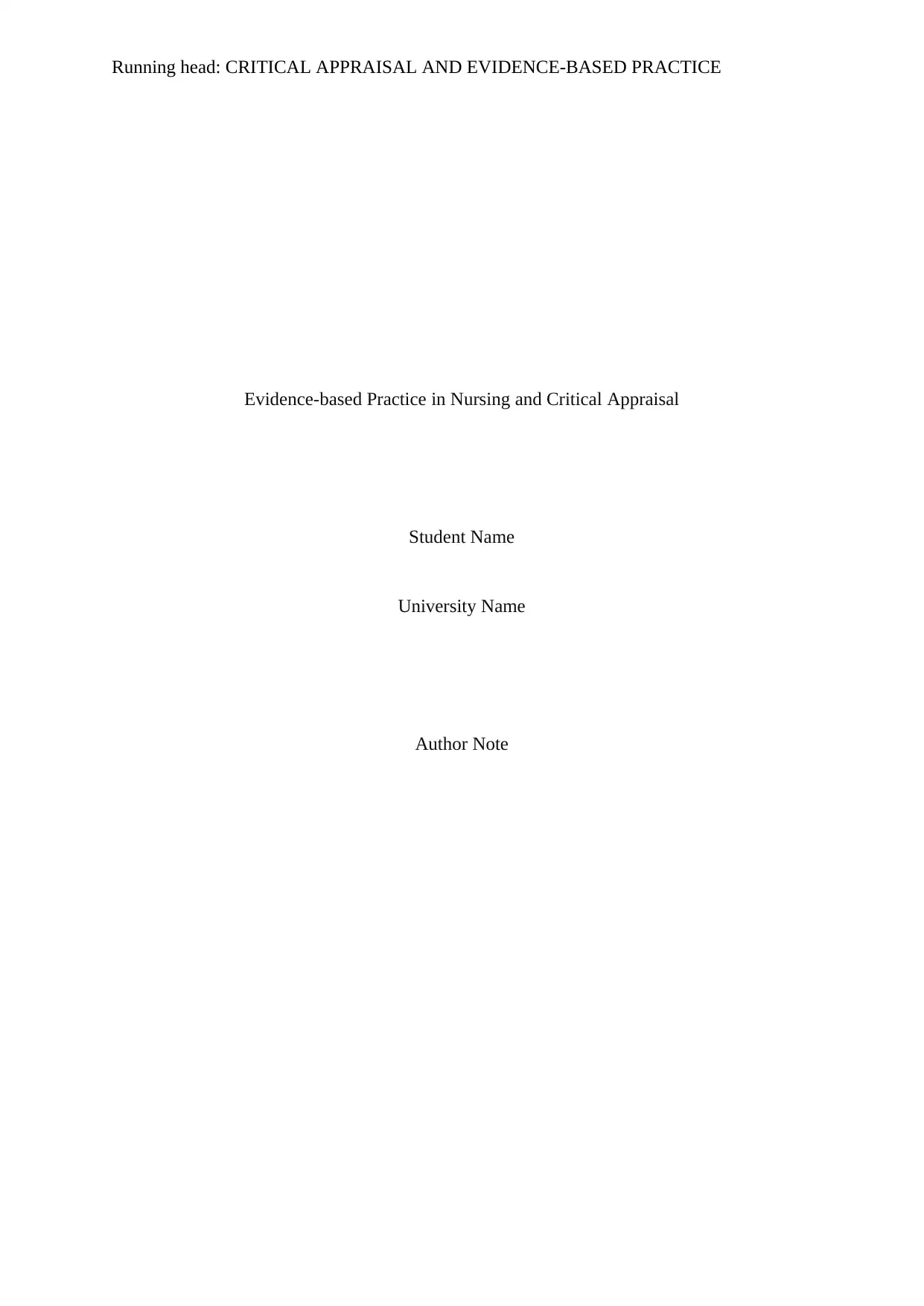
Running head: CRITICAL APPRAISAL AND EVIDENCE-BASED PRACTICE
Evidence-based Practice in Nursing and Critical Appraisal
Student Name
University Name
Author Note
Evidence-based Practice in Nursing and Critical Appraisal
Student Name
University Name
Author Note
Paraphrase This Document
Need a fresh take? Get an instant paraphrase of this document with our AI Paraphraser
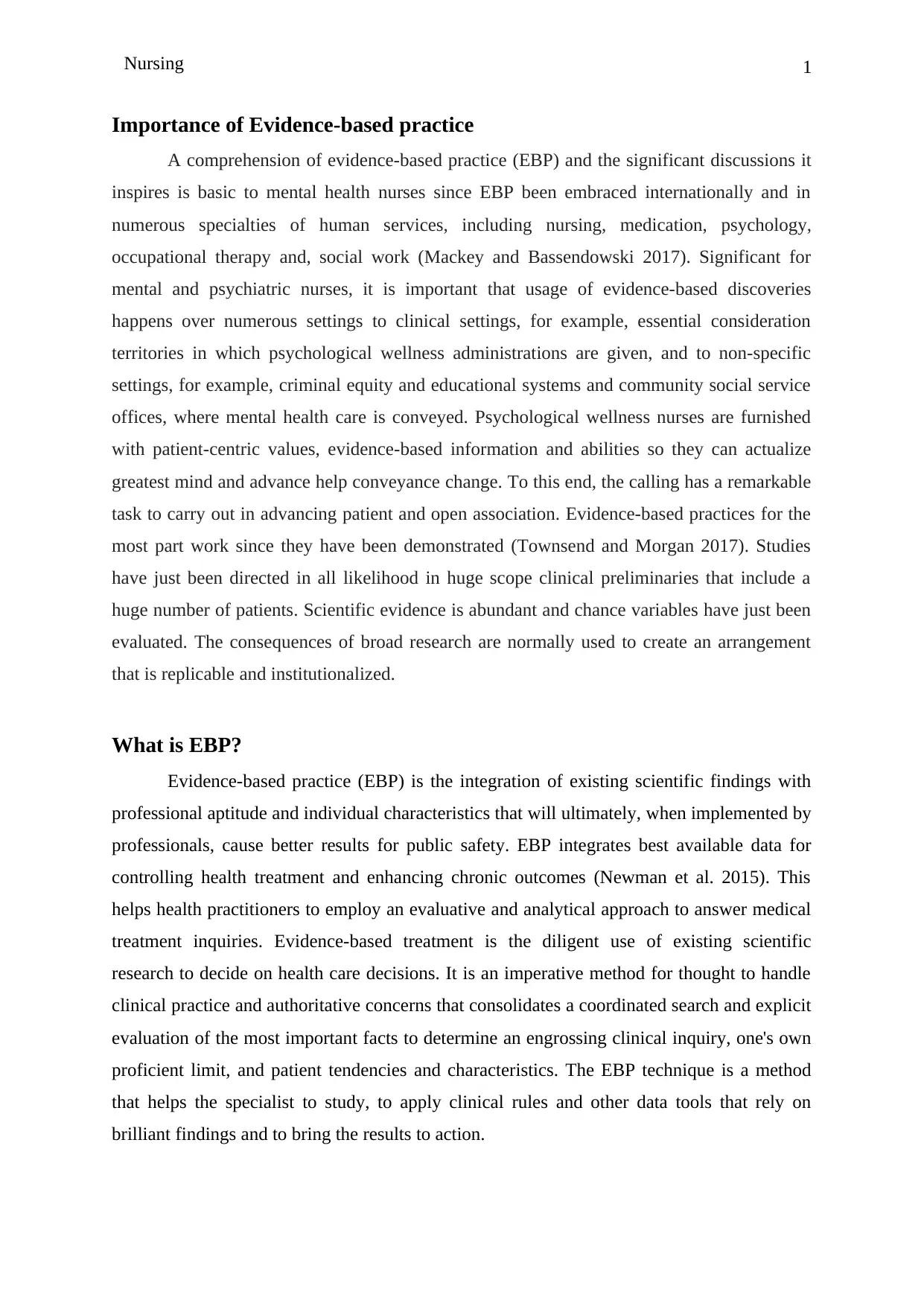
1
Importance of Evidence-based practice
A comprehension of evidence-based practice (EBP) and the significant discussions it
inspires is basic to mental health nurses since EBP been embraced internationally and in
numerous specialties of human services, including nursing, medication, psychology,
occupational therapy and, social work (Mackey and Bassendowski 2017). Significant for
mental and psychiatric nurses, it is important that usage of evidence-based discoveries
happens over numerous settings to clinical settings, for example, essential consideration
territories in which psychological wellness administrations are given, and to non-specific
settings, for example, criminal equity and educational systems and community social service
offices, where mental health care is conveyed. Psychological wellness nurses are furnished
with patient-centric values, evidence-based information and abilities so they can actualize
greatest mind and advance help conveyance change. To this end, the calling has a remarkable
task to carry out in advancing patient and open association. Evidence-based practices for the
most part work since they have been demonstrated (Townsend and Morgan 2017). Studies
have just been directed in all likelihood in huge scope clinical preliminaries that include a
huge number of patients. Scientific evidence is abundant and chance variables have just been
evaluated. The consequences of broad research are normally used to create an arrangement
that is replicable and institutionalized.
What is EBP?
Evidence-based practice (EBP) is the integration of existing scientific findings with
professional aptitude and individual characteristics that will ultimately, when implemented by
professionals, cause better results for public safety. EBP integrates best available data for
controlling health treatment and enhancing chronic outcomes (Newman et al. 2015). This
helps health practitioners to employ an evaluative and analytical approach to answer medical
treatment inquiries. Evidence-based treatment is the diligent use of existing scientific
research to decide on health care decisions. It is an imperative method for thought to handle
clinical practice and authoritative concerns that consolidates a coordinated search and explicit
evaluation of the most important facts to determine an engrossing clinical inquiry, one's own
proficient limit, and patient tendencies and characteristics. The EBP technique is a method
that helps the specialist to study, to apply clinical rules and other data tools that rely on
brilliant findings and to bring the results to action.
Nursing
Importance of Evidence-based practice
A comprehension of evidence-based practice (EBP) and the significant discussions it
inspires is basic to mental health nurses since EBP been embraced internationally and in
numerous specialties of human services, including nursing, medication, psychology,
occupational therapy and, social work (Mackey and Bassendowski 2017). Significant for
mental and psychiatric nurses, it is important that usage of evidence-based discoveries
happens over numerous settings to clinical settings, for example, essential consideration
territories in which psychological wellness administrations are given, and to non-specific
settings, for example, criminal equity and educational systems and community social service
offices, where mental health care is conveyed. Psychological wellness nurses are furnished
with patient-centric values, evidence-based information and abilities so they can actualize
greatest mind and advance help conveyance change. To this end, the calling has a remarkable
task to carry out in advancing patient and open association. Evidence-based practices for the
most part work since they have been demonstrated (Townsend and Morgan 2017). Studies
have just been directed in all likelihood in huge scope clinical preliminaries that include a
huge number of patients. Scientific evidence is abundant and chance variables have just been
evaluated. The consequences of broad research are normally used to create an arrangement
that is replicable and institutionalized.
What is EBP?
Evidence-based practice (EBP) is the integration of existing scientific findings with
professional aptitude and individual characteristics that will ultimately, when implemented by
professionals, cause better results for public safety. EBP integrates best available data for
controlling health treatment and enhancing chronic outcomes (Newman et al. 2015). This
helps health practitioners to employ an evaluative and analytical approach to answer medical
treatment inquiries. Evidence-based treatment is the diligent use of existing scientific
research to decide on health care decisions. It is an imperative method for thought to handle
clinical practice and authoritative concerns that consolidates a coordinated search and explicit
evaluation of the most important facts to determine an engrossing clinical inquiry, one's own
proficient limit, and patient tendencies and characteristics. The EBP technique is a method
that helps the specialist to study, to apply clinical rules and other data tools that rely on
brilliant findings and to bring the results to action.
Nursing
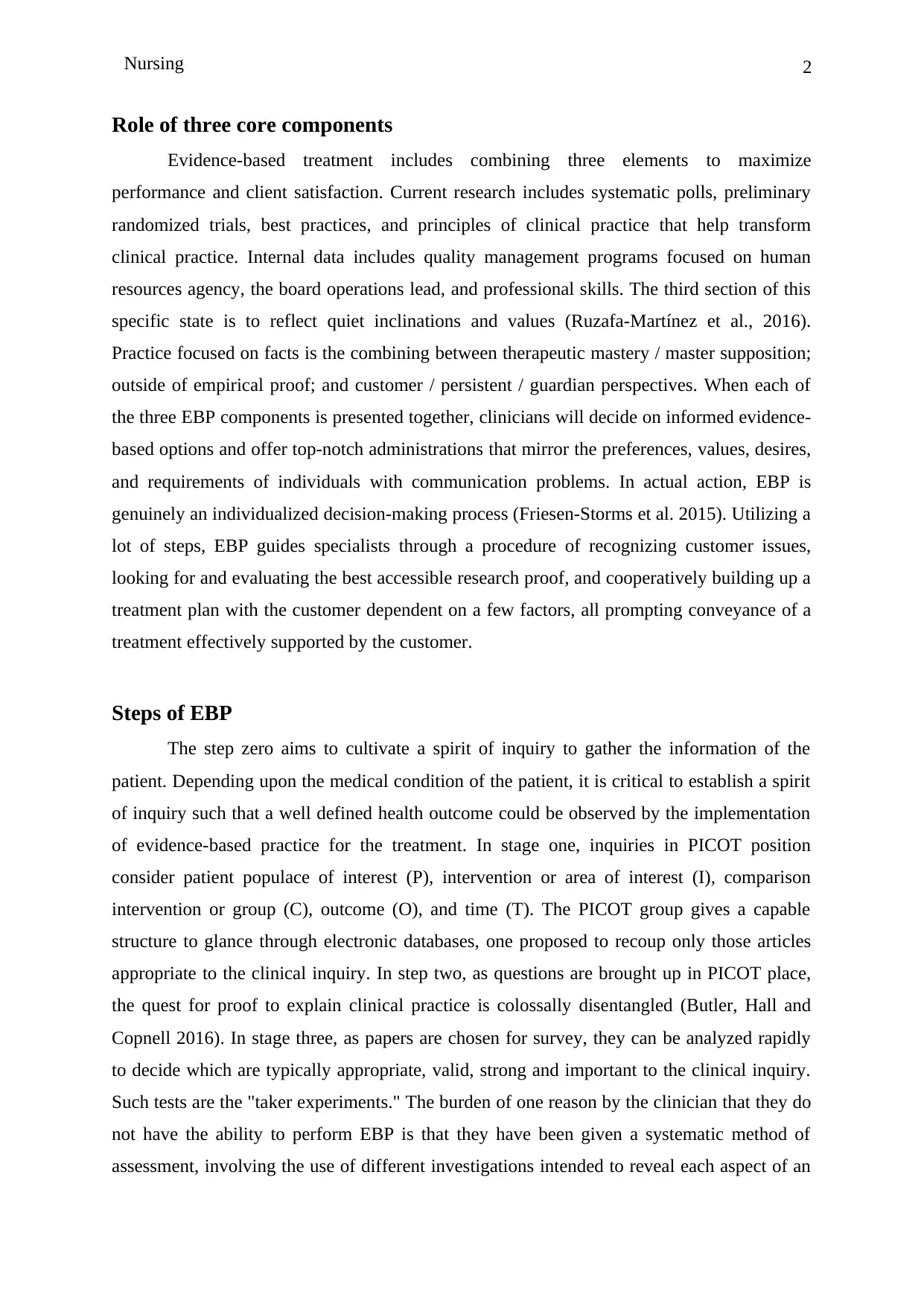
2
Role of three core components
Evidence-based treatment includes combining three elements to maximize
performance and client satisfaction. Current research includes systematic polls, preliminary
randomized trials, best practices, and principles of clinical practice that help transform
clinical practice. Internal data includes quality management programs focused on human
resources agency, the board operations lead, and professional skills. The third section of this
specific state is to reflect quiet inclinations and values (Ruzafa-Martínez et al., 2016).
Practice focused on facts is the combining between therapeutic mastery / master supposition;
outside of empirical proof; and customer / persistent / guardian perspectives. When each of
the three EBP components is presented together, clinicians will decide on informed evidence-
based options and offer top-notch administrations that mirror the preferences, values, desires,
and requirements of individuals with communication problems. In actual action, EBP is
genuinely an individualized decision-making process (Friesen-Storms et al. 2015). Utilizing a
lot of steps, EBP guides specialists through a procedure of recognizing customer issues,
looking for and evaluating the best accessible research proof, and cooperatively building up a
treatment plan with the customer dependent on a few factors, all prompting conveyance of a
treatment effectively supported by the customer.
Steps of EBP
The step zero aims to cultivate a spirit of inquiry to gather the information of the
patient. Depending upon the medical condition of the patient, it is critical to establish a spirit
of inquiry such that a well defined health outcome could be observed by the implementation
of evidence-based practice for the treatment. In stage one, inquiries in PICOT position
consider patient populace of interest (P), intervention or area of interest (I), comparison
intervention or group (C), outcome (O), and time (T). The PICOT group gives a capable
structure to glance through electronic databases, one proposed to recoup only those articles
appropriate to the clinical inquiry. In step two, as questions are brought up in PICOT place,
the quest for proof to explain clinical practice is colossally disentangled (Butler, Hall and
Copnell 2016). In stage three, as papers are chosen for survey, they can be analyzed rapidly
to decide which are typically appropriate, valid, strong and important to the clinical inquiry.
Such tests are the "taker experiments." The burden of one reason by the clinician that they do
not have the ability to perform EBP is that they have been given a systematic method of
assessment, involving the use of different investigations intended to reveal each aspect of an
Nursing
Role of three core components
Evidence-based treatment includes combining three elements to maximize
performance and client satisfaction. Current research includes systematic polls, preliminary
randomized trials, best practices, and principles of clinical practice that help transform
clinical practice. Internal data includes quality management programs focused on human
resources agency, the board operations lead, and professional skills. The third section of this
specific state is to reflect quiet inclinations and values (Ruzafa-Martínez et al., 2016).
Practice focused on facts is the combining between therapeutic mastery / master supposition;
outside of empirical proof; and customer / persistent / guardian perspectives. When each of
the three EBP components is presented together, clinicians will decide on informed evidence-
based options and offer top-notch administrations that mirror the preferences, values, desires,
and requirements of individuals with communication problems. In actual action, EBP is
genuinely an individualized decision-making process (Friesen-Storms et al. 2015). Utilizing a
lot of steps, EBP guides specialists through a procedure of recognizing customer issues,
looking for and evaluating the best accessible research proof, and cooperatively building up a
treatment plan with the customer dependent on a few factors, all prompting conveyance of a
treatment effectively supported by the customer.
Steps of EBP
The step zero aims to cultivate a spirit of inquiry to gather the information of the
patient. Depending upon the medical condition of the patient, it is critical to establish a spirit
of inquiry such that a well defined health outcome could be observed by the implementation
of evidence-based practice for the treatment. In stage one, inquiries in PICOT position
consider patient populace of interest (P), intervention or area of interest (I), comparison
intervention or group (C), outcome (O), and time (T). The PICOT group gives a capable
structure to glance through electronic databases, one proposed to recoup only those articles
appropriate to the clinical inquiry. In step two, as questions are brought up in PICOT place,
the quest for proof to explain clinical practice is colossally disentangled (Butler, Hall and
Copnell 2016). In stage three, as papers are chosen for survey, they can be analyzed rapidly
to decide which are typically appropriate, valid, strong and important to the clinical inquiry.
Such tests are the "taker experiments." The burden of one reason by the clinician that they do
not have the ability to perform EBP is that they have been given a systematic method of
assessment, involving the use of different investigations intended to reveal each aspect of an
Nursing
⊘ This is a preview!⊘
Do you want full access?
Subscribe today to unlock all pages.

Trusted by 1+ million students worldwide
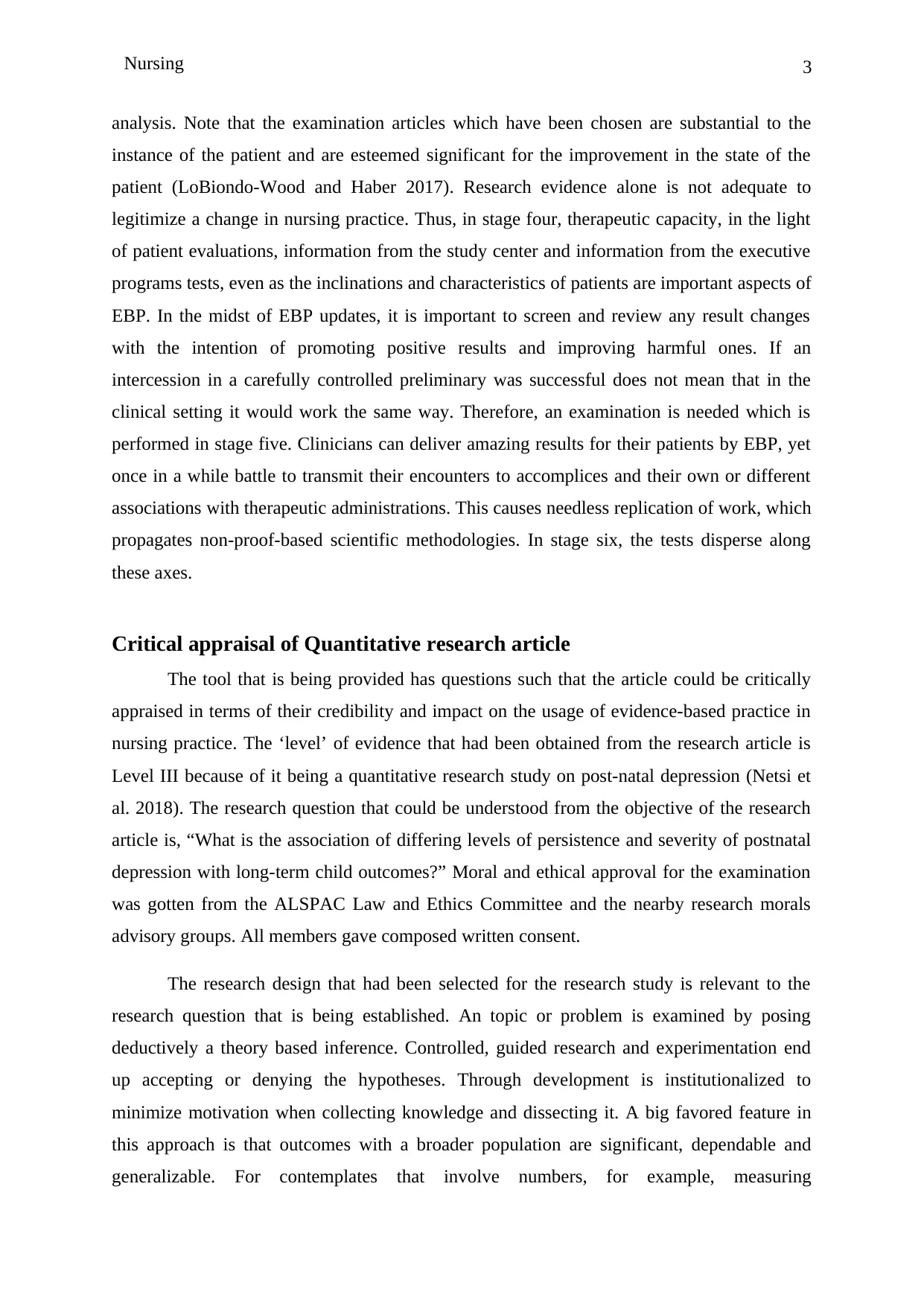
3
analysis. Note that the examination articles which have been chosen are substantial to the
instance of the patient and are esteemed significant for the improvement in the state of the
patient (LoBiondo-Wood and Haber 2017). Research evidence alone is not adequate to
legitimize a change in nursing practice. Thus, in stage four, therapeutic capacity, in the light
of patient evaluations, information from the study center and information from the executive
programs tests, even as the inclinations and characteristics of patients are important aspects of
EBP. In the midst of EBP updates, it is important to screen and review any result changes
with the intention of promoting positive results and improving harmful ones. If an
intercession in a carefully controlled preliminary was successful does not mean that in the
clinical setting it would work the same way. Therefore, an examination is needed which is
performed in stage five. Clinicians can deliver amazing results for their patients by EBP, yet
once in a while battle to transmit their encounters to accomplices and their own or different
associations with therapeutic administrations. This causes needless replication of work, which
propagates non-proof-based scientific methodologies. In stage six, the tests disperse along
these axes.
Critical appraisal of Quantitative research article
The tool that is being provided has questions such that the article could be critically
appraised in terms of their credibility and impact on the usage of evidence-based practice in
nursing practice. The ‘level’ of evidence that had been obtained from the research article is
Level III because of it being a quantitative research study on post-natal depression (Netsi et
al. 2018). The research question that could be understood from the objective of the research
article is, “What is the association of differing levels of persistence and severity of postnatal
depression with long-term child outcomes?” Moral and ethical approval for the examination
was gotten from the ALSPAC Law and Ethics Committee and the nearby research morals
advisory groups. All members gave composed written consent.
The research design that had been selected for the research study is relevant to the
research question that is being established. An topic or problem is examined by posing
deductively a theory based inference. Controlled, guided research and experimentation end
up accepting or denying the hypotheses. Through development is institutionalized to
minimize motivation when collecting knowledge and dissecting it. A big favored feature in
this approach is that outcomes with a broader population are significant, dependable and
generalizable. For contemplates that involve numbers, for example, measuring
Nursing
analysis. Note that the examination articles which have been chosen are substantial to the
instance of the patient and are esteemed significant for the improvement in the state of the
patient (LoBiondo-Wood and Haber 2017). Research evidence alone is not adequate to
legitimize a change in nursing practice. Thus, in stage four, therapeutic capacity, in the light
of patient evaluations, information from the study center and information from the executive
programs tests, even as the inclinations and characteristics of patients are important aspects of
EBP. In the midst of EBP updates, it is important to screen and review any result changes
with the intention of promoting positive results and improving harmful ones. If an
intercession in a carefully controlled preliminary was successful does not mean that in the
clinical setting it would work the same way. Therefore, an examination is needed which is
performed in stage five. Clinicians can deliver amazing results for their patients by EBP, yet
once in a while battle to transmit their encounters to accomplices and their own or different
associations with therapeutic administrations. This causes needless replication of work, which
propagates non-proof-based scientific methodologies. In stage six, the tests disperse along
these axes.
Critical appraisal of Quantitative research article
The tool that is being provided has questions such that the article could be critically
appraised in terms of their credibility and impact on the usage of evidence-based practice in
nursing practice. The ‘level’ of evidence that had been obtained from the research article is
Level III because of it being a quantitative research study on post-natal depression (Netsi et
al. 2018). The research question that could be understood from the objective of the research
article is, “What is the association of differing levels of persistence and severity of postnatal
depression with long-term child outcomes?” Moral and ethical approval for the examination
was gotten from the ALSPAC Law and Ethics Committee and the nearby research morals
advisory groups. All members gave composed written consent.
The research design that had been selected for the research study is relevant to the
research question that is being established. An topic or problem is examined by posing
deductively a theory based inference. Controlled, guided research and experimentation end
up accepting or denying the hypotheses. Through development is institutionalized to
minimize motivation when collecting knowledge and dissecting it. A big favored feature in
this approach is that outcomes with a broader population are significant, dependable and
generalizable. For contemplates that involve numbers, for example, measuring
Nursing
Paraphrase This Document
Need a fresh take? Get an instant paraphrase of this document with our AI Paraphraser
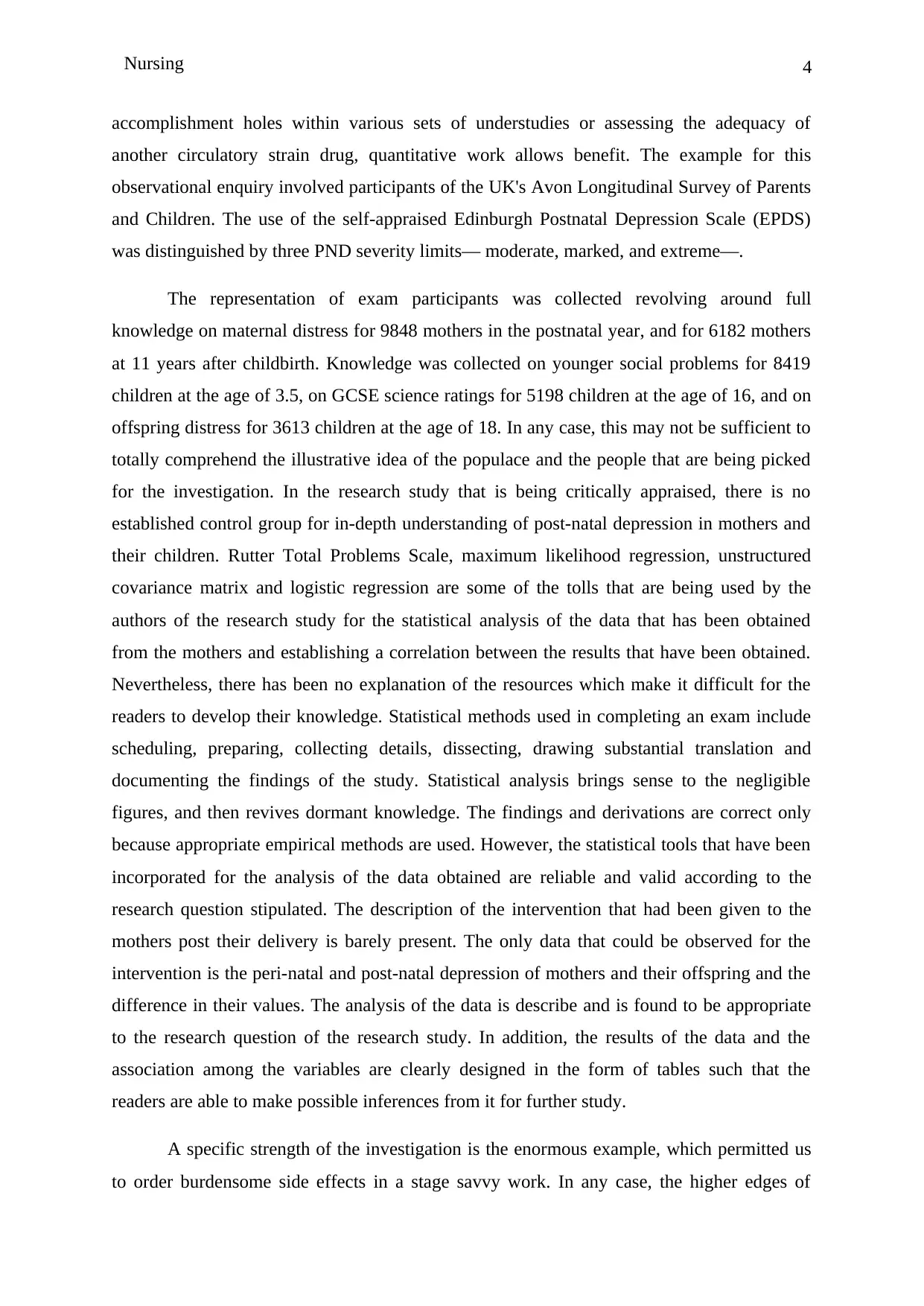
4
accomplishment holes within various sets of understudies or assessing the adequacy of
another circulatory strain drug, quantitative work allows benefit. The example for this
observational enquiry involved participants of the UK's Avon Longitudinal Survey of Parents
and Children. The use of the self-appraised Edinburgh Postnatal Depression Scale (EPDS)
was distinguished by three PND severity limits— moderate, marked, and extreme—.
The representation of exam participants was collected revolving around full
knowledge on maternal distress for 9848 mothers in the postnatal year, and for 6182 mothers
at 11 years after childbirth. Knowledge was collected on younger social problems for 8419
children at the age of 3.5, on GCSE science ratings for 5198 children at the age of 16, and on
offspring distress for 3613 children at the age of 18. In any case, this may not be sufficient to
totally comprehend the illustrative idea of the populace and the people that are being picked
for the investigation. In the research study that is being critically appraised, there is no
established control group for in-depth understanding of post-natal depression in mothers and
their children. Rutter Total Problems Scale, maximum likelihood regression, unstructured
covariance matrix and logistic regression are some of the tolls that are being used by the
authors of the research study for the statistical analysis of the data that has been obtained
from the mothers and establishing a correlation between the results that have been obtained.
Nevertheless, there has been no explanation of the resources which make it difficult for the
readers to develop their knowledge. Statistical methods used in completing an exam include
scheduling, preparing, collecting details, dissecting, drawing substantial translation and
documenting the findings of the study. Statistical analysis brings sense to the negligible
figures, and then revives dormant knowledge. The findings and derivations are correct only
because appropriate empirical methods are used. However, the statistical tools that have been
incorporated for the analysis of the data obtained are reliable and valid according to the
research question stipulated. The description of the intervention that had been given to the
mothers post their delivery is barely present. The only data that could be observed for the
intervention is the peri-natal and post-natal depression of mothers and their offspring and the
difference in their values. The analysis of the data is describe and is found to be appropriate
to the research question of the research study. In addition, the results of the data and the
association among the variables are clearly designed in the form of tables such that the
readers are able to make possible inferences from it for further study.
A specific strength of the investigation is the enormous example, which permitted us
to order burdensome side effects in a stage savvy work. In any case, the higher edges of
Nursing
accomplishment holes within various sets of understudies or assessing the adequacy of
another circulatory strain drug, quantitative work allows benefit. The example for this
observational enquiry involved participants of the UK's Avon Longitudinal Survey of Parents
and Children. The use of the self-appraised Edinburgh Postnatal Depression Scale (EPDS)
was distinguished by three PND severity limits— moderate, marked, and extreme—.
The representation of exam participants was collected revolving around full
knowledge on maternal distress for 9848 mothers in the postnatal year, and for 6182 mothers
at 11 years after childbirth. Knowledge was collected on younger social problems for 8419
children at the age of 3.5, on GCSE science ratings for 5198 children at the age of 16, and on
offspring distress for 3613 children at the age of 18. In any case, this may not be sufficient to
totally comprehend the illustrative idea of the populace and the people that are being picked
for the investigation. In the research study that is being critically appraised, there is no
established control group for in-depth understanding of post-natal depression in mothers and
their children. Rutter Total Problems Scale, maximum likelihood regression, unstructured
covariance matrix and logistic regression are some of the tolls that are being used by the
authors of the research study for the statistical analysis of the data that has been obtained
from the mothers and establishing a correlation between the results that have been obtained.
Nevertheless, there has been no explanation of the resources which make it difficult for the
readers to develop their knowledge. Statistical methods used in completing an exam include
scheduling, preparing, collecting details, dissecting, drawing substantial translation and
documenting the findings of the study. Statistical analysis brings sense to the negligible
figures, and then revives dormant knowledge. The findings and derivations are correct only
because appropriate empirical methods are used. However, the statistical tools that have been
incorporated for the analysis of the data obtained are reliable and valid according to the
research question stipulated. The description of the intervention that had been given to the
mothers post their delivery is barely present. The only data that could be observed for the
intervention is the peri-natal and post-natal depression of mothers and their offspring and the
difference in their values. The analysis of the data is describe and is found to be appropriate
to the research question of the research study. In addition, the results of the data and the
association among the variables are clearly designed in the form of tables such that the
readers are able to make possible inferences from it for further study.
A specific strength of the investigation is the enormous example, which permitted us
to order burdensome side effects in a stage savvy work. In any case, the higher edges of
Nursing
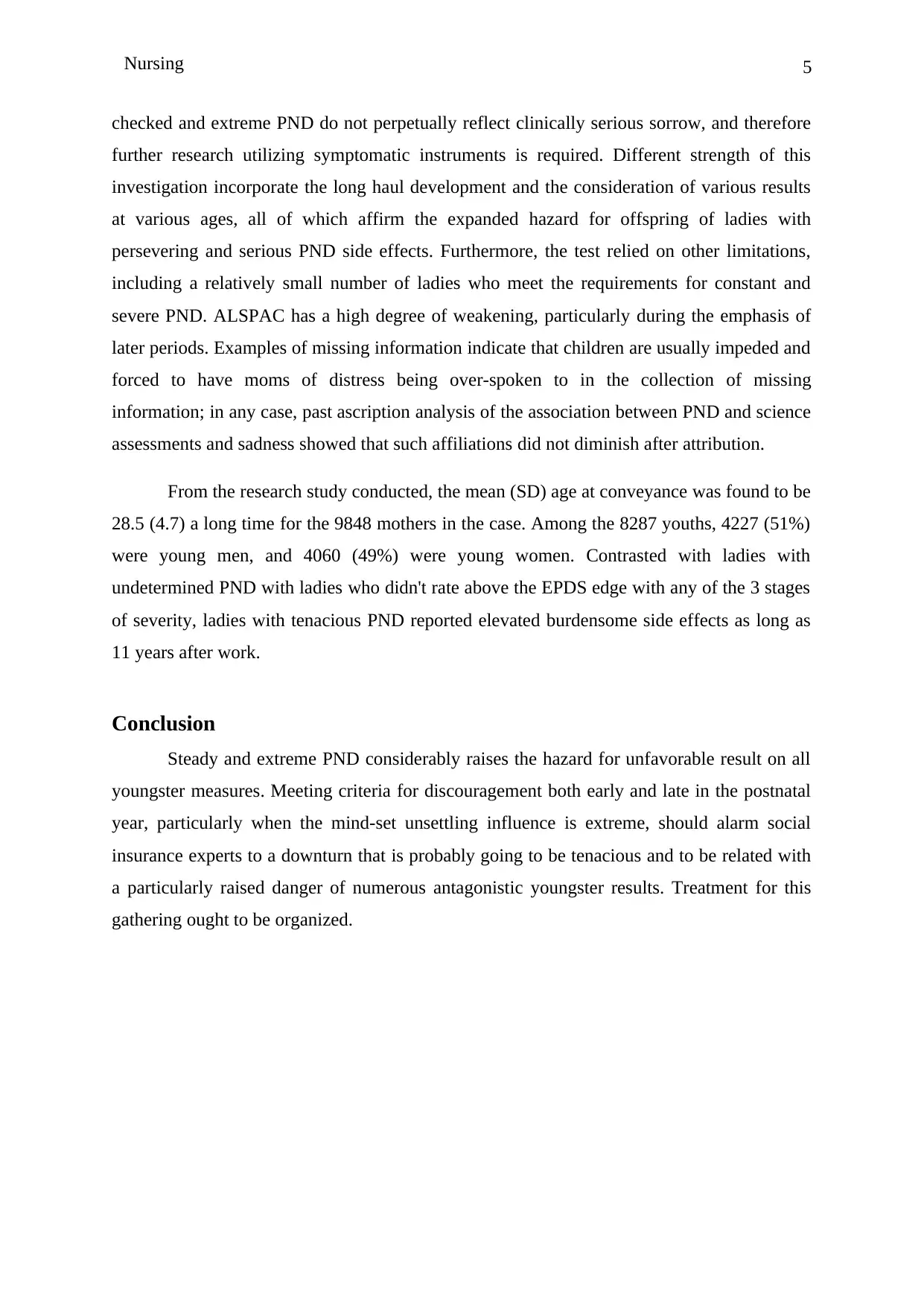
5
checked and extreme PND do not perpetually reflect clinically serious sorrow, and therefore
further research utilizing symptomatic instruments is required. Different strength of this
investigation incorporate the long haul development and the consideration of various results
at various ages, all of which affirm the expanded hazard for offspring of ladies with
persevering and serious PND side effects. Furthermore, the test relied on other limitations,
including a relatively small number of ladies who meet the requirements for constant and
severe PND. ALSPAC has a high degree of weakening, particularly during the emphasis of
later periods. Examples of missing information indicate that children are usually impeded and
forced to have moms of distress being over-spoken to in the collection of missing
information; in any case, past ascription analysis of the association between PND and science
assessments and sadness showed that such affiliations did not diminish after attribution.
From the research study conducted, the mean (SD) age at conveyance was found to be
28.5 (4.7) a long time for the 9848 mothers in the case. Among the 8287 youths, 4227 (51%)
were young men, and 4060 (49%) were young women. Contrasted with ladies with
undetermined PND with ladies who didn't rate above the EPDS edge with any of the 3 stages
of severity, ladies with tenacious PND reported elevated burdensome side effects as long as
11 years after work.
Conclusion
Steady and extreme PND considerably raises the hazard for unfavorable result on all
youngster measures. Meeting criteria for discouragement both early and late in the postnatal
year, particularly when the mind-set unsettling influence is extreme, should alarm social
insurance experts to a downturn that is probably going to be tenacious and to be related with
a particularly raised danger of numerous antagonistic youngster results. Treatment for this
gathering ought to be organized.
Nursing
checked and extreme PND do not perpetually reflect clinically serious sorrow, and therefore
further research utilizing symptomatic instruments is required. Different strength of this
investigation incorporate the long haul development and the consideration of various results
at various ages, all of which affirm the expanded hazard for offspring of ladies with
persevering and serious PND side effects. Furthermore, the test relied on other limitations,
including a relatively small number of ladies who meet the requirements for constant and
severe PND. ALSPAC has a high degree of weakening, particularly during the emphasis of
later periods. Examples of missing information indicate that children are usually impeded and
forced to have moms of distress being over-spoken to in the collection of missing
information; in any case, past ascription analysis of the association between PND and science
assessments and sadness showed that such affiliations did not diminish after attribution.
From the research study conducted, the mean (SD) age at conveyance was found to be
28.5 (4.7) a long time for the 9848 mothers in the case. Among the 8287 youths, 4227 (51%)
were young men, and 4060 (49%) were young women. Contrasted with ladies with
undetermined PND with ladies who didn't rate above the EPDS edge with any of the 3 stages
of severity, ladies with tenacious PND reported elevated burdensome side effects as long as
11 years after work.
Conclusion
Steady and extreme PND considerably raises the hazard for unfavorable result on all
youngster measures. Meeting criteria for discouragement both early and late in the postnatal
year, particularly when the mind-set unsettling influence is extreme, should alarm social
insurance experts to a downturn that is probably going to be tenacious and to be related with
a particularly raised danger of numerous antagonistic youngster results. Treatment for this
gathering ought to be organized.
Nursing
⊘ This is a preview!⊘
Do you want full access?
Subscribe today to unlock all pages.

Trusted by 1+ million students worldwide
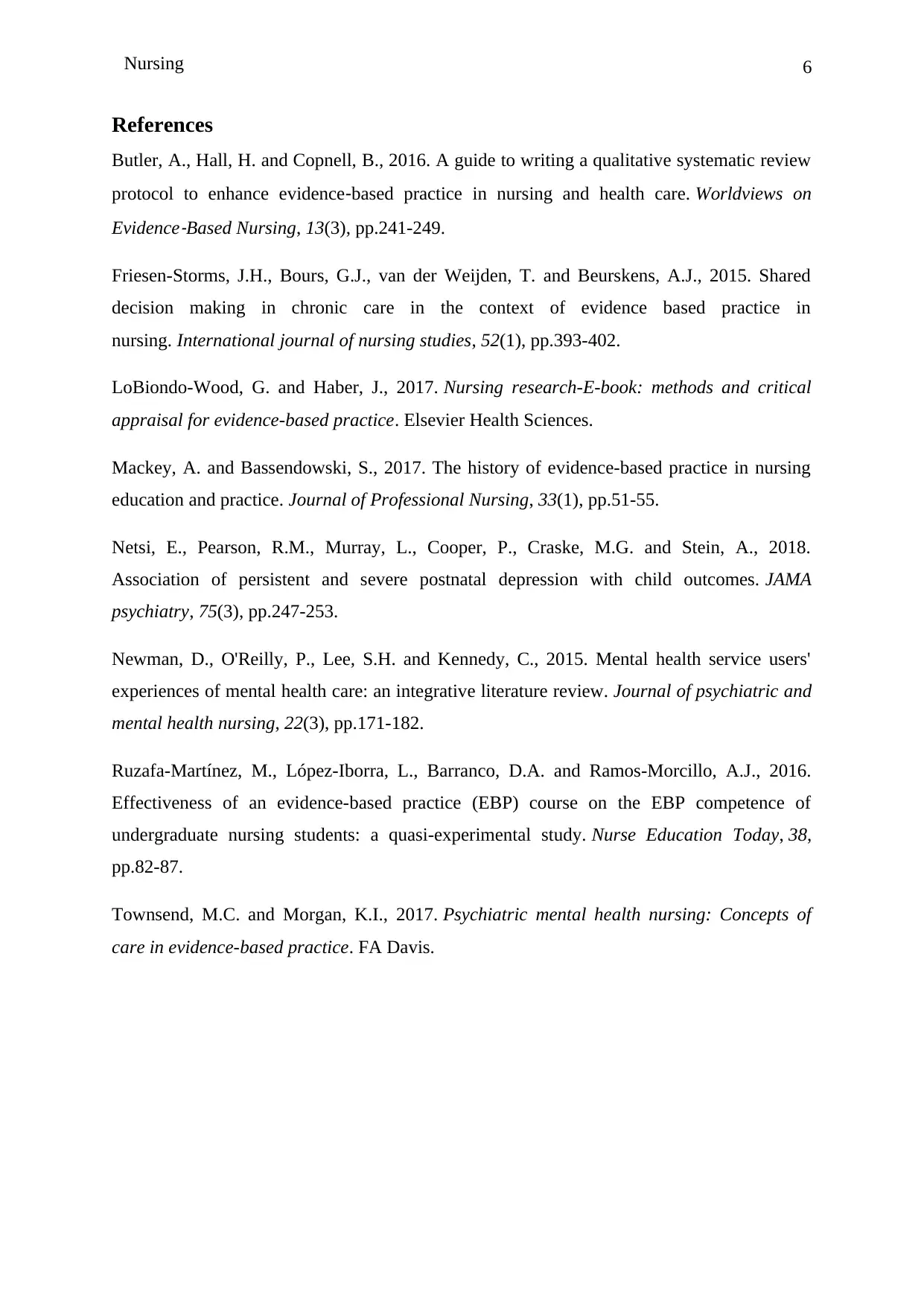
6
References
Butler, A., Hall, H. and Copnell, B., 2016. A guide to writing a qualitative systematic review
protocol to enhance evidence‐based practice in nursing and health care. Worldviews on
Evidence
‐Based Nursing, 13(3), pp.241-249.
Friesen-Storms, J.H., Bours, G.J., van der Weijden, T. and Beurskens, A.J., 2015. Shared
decision making in chronic care in the context of evidence based practice in
nursing. International journal of nursing studies, 52(1), pp.393-402.
LoBiondo-Wood, G. and Haber, J., 2017. Nursing research-E-book: methods and critical
appraisal for evidence-based practice. Elsevier Health Sciences.
Mackey, A. and Bassendowski, S., 2017. The history of evidence-based practice in nursing
education and practice. Journal of Professional Nursing, 33(1), pp.51-55.
Netsi, E., Pearson, R.M., Murray, L., Cooper, P., Craske, M.G. and Stein, A., 2018.
Association of persistent and severe postnatal depression with child outcomes. JAMA
psychiatry, 75(3), pp.247-253.
Newman, D., O'Reilly, P., Lee, S.H. and Kennedy, C., 2015. Mental health service users'
experiences of mental health care: an integrative literature review. Journal of psychiatric and
mental health nursing, 22(3), pp.171-182.
Ruzafa-Martínez, M., López-Iborra, L., Barranco, D.A. and Ramos-Morcillo, A.J., 2016.
Effectiveness of an evidence-based practice (EBP) course on the EBP competence of
undergraduate nursing students: a quasi-experimental study. Nurse Education Today, 38,
pp.82-87.
Townsend, M.C. and Morgan, K.I., 2017. Psychiatric mental health nursing: Concepts of
care in evidence-based practice. FA Davis.
Nursing
References
Butler, A., Hall, H. and Copnell, B., 2016. A guide to writing a qualitative systematic review
protocol to enhance evidence‐based practice in nursing and health care. Worldviews on
Evidence
‐Based Nursing, 13(3), pp.241-249.
Friesen-Storms, J.H., Bours, G.J., van der Weijden, T. and Beurskens, A.J., 2015. Shared
decision making in chronic care in the context of evidence based practice in
nursing. International journal of nursing studies, 52(1), pp.393-402.
LoBiondo-Wood, G. and Haber, J., 2017. Nursing research-E-book: methods and critical
appraisal for evidence-based practice. Elsevier Health Sciences.
Mackey, A. and Bassendowski, S., 2017. The history of evidence-based practice in nursing
education and practice. Journal of Professional Nursing, 33(1), pp.51-55.
Netsi, E., Pearson, R.M., Murray, L., Cooper, P., Craske, M.G. and Stein, A., 2018.
Association of persistent and severe postnatal depression with child outcomes. JAMA
psychiatry, 75(3), pp.247-253.
Newman, D., O'Reilly, P., Lee, S.H. and Kennedy, C., 2015. Mental health service users'
experiences of mental health care: an integrative literature review. Journal of psychiatric and
mental health nursing, 22(3), pp.171-182.
Ruzafa-Martínez, M., López-Iborra, L., Barranco, D.A. and Ramos-Morcillo, A.J., 2016.
Effectiveness of an evidence-based practice (EBP) course on the EBP competence of
undergraduate nursing students: a quasi-experimental study. Nurse Education Today, 38,
pp.82-87.
Townsend, M.C. and Morgan, K.I., 2017. Psychiatric mental health nursing: Concepts of
care in evidence-based practice. FA Davis.
Nursing
1 out of 7
Related Documents
Your All-in-One AI-Powered Toolkit for Academic Success.
+13062052269
info@desklib.com
Available 24*7 on WhatsApp / Email
![[object Object]](/_next/static/media/star-bottom.7253800d.svg)
Unlock your academic potential
Copyright © 2020–2025 A2Z Services. All Rights Reserved. Developed and managed by ZUCOL.





